
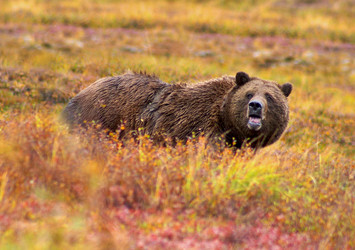
A grizzly bear in Denali National Park, Alaska. Image © 2004 Jean-Pierre Lavoie
Introduction
For years the grizzly bear, Ursus arctos horribilis, has been a majestic and powerful symbol of the wilderness. It is no wonder, as these massive bears are among the largest land carnivores in the world. Grizzlies are the most widespread brown bears of North America, and since the 1970’s these bears have been under intense study following a massive population crash in the 19th and 20th centuries. This treehouse will provide information on the past and present life of grizzlies, as well as insight into their unpredictable future.
Evolutionary History
The evolution of bears begins in the early Miocene era, approximately 20 mya (million years ago), when the first bear type animal named Ursavus elmensis evolved from a dog-like ancestor (Hitchcock, 2004). Fossil records from U. elmensis show carnassial teeth with larger molars for more chewing area, a trait common to present day bears. Another early bear in the lineage leading to grizzlies is Ursus minimus of the cave line bears, which lived in the Pliocene era, about 10 mya. The cave line bears persisted until the most recent ice age 10,000 years ago but then became extinct. However, roughly 1.5 mya a new lineage of bears diverged from the cave bear line. These bears, which were most similar to Ursus etruscus of the cave bear line, were the common ancestors of the brown bears, Ursus arctos, and the black bears, Ursus americanus. The closest relative of the brown bear is the polar bear, which diverged from U. arctos about 300,000 years ago. Brown bears have diverged into a large number of subspecies, one of which being the grizzly bear common to North America.
Distribution
Grizzly bears typically live in mountain ranges where rich forests and plenty of streams are found. They will also make use of scattered meadows and grasslands within the mountains, providing a diverse environment for the grizzly to live in (US Fish and Wildlife Service, 2000).
Grizzly bears presently occupy a range that spans from the pacific coast of Alaska to Hudson’s Bay in the North, as well as most of British Columbia and some of Alberta in Canada. It is estimated that there are more than 30,000 grizzly bears in Alaska as well as 25,000 or more in Western Canada (US Fish and Wildlife, 2000). There are also approximately 1,200–1,400 grizzly bears residing in the lower 48 states of the USA (Servheen, 2008). Although most are found in the Yellowstone area and the Northern Continental Divide Ecosystem, small populations live in the North Cascades region, the Selkirk Mountains and the Cabinet Yaak area. There is a recovery zone for grizzly bears in the Bitteroot Mountains of the Northern US, but no grizzly bears live there yet.
Historically, grizzly bears could be found in much of North America, with populations spanning from the Arctic Ocean as far south as Mexico, and as far east as the Mississippi River (Ministry of Environment, 1996). Approximately 50,000 grizzly bears lived in the lower US and Mexico in the early 1800’s. Habitat destruction by humans and hunting have lead to their drastic decrease in population (US Fish and Wildlife, 2000).
Physical Characteristics
Grizzly bears are among the largest land carnivores in the world. Males are 38% larger than females and typically reach a weight of 300 to 800 pounds depending on where they live. Females grow from 200 to 400 pounds. The heaviest recorded grizzly was 1496 pounds (Brown, 1993). Grizzlies grow to an average size of 6-7 feet when standing up and 3-4 feet to the top of their shoulders when on all fours. The large hump found on their shoulders is mainly composed of muscle and fat. This provides them with exceptional digging power useful when carving out dens or searching for food. Grizzlies are avid swimmers and very fast runners, reaching speeds of up to 56km/h (35mph) in a sprint. Like most other bears, grizzlies have short, stubby tails.
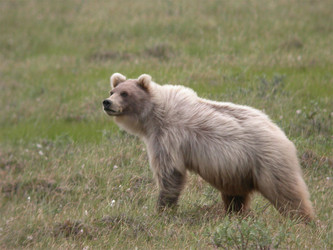
A grizzly bear on the North Slope of Alaska, USA. The grizzlys of the tundra are much lighter in color, due to the constant exposure to the sun. © 2005 David LaPuma
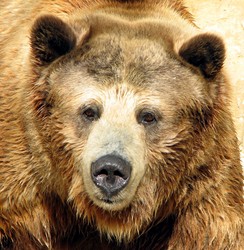
Head of an adult grizzly. © 2008 Brit
Fur
- The fur of a grizzly bear can be anywhere from a cream colour to a nearly black, dark brown coat (Brown, 1993)
- Cubs usually have a lighter coat
- The tips of their fur is white or silver which gives them a grizzled look, and led to their name, the grizzly bear
- Their pelt is highly insulating and protects bears from insects and the environment
- Their colour helps grizzly bears blend in with their surroundings to avoid enemies and remain unknown to prey
Teeth
- Grizzly bears have 42 teeth (Brown, 1993)
- Several longer, sharp teeth are located towards the front of their mouth for tearing meat
- As they are omnivores, they have large, flat molars used for grinding
- Cubs begin losing their juvenile teeth at 5-6 months of age and have a full set of adult teeth at 1.5 years old (Zavatsky, 1974)
Head
- Large head in relation to body size
- Skull length ranges from 30-40 cm
- Cubs have nearly round heads, which lengthen and change shape as they reach sexual maturity to assume the adult structure (Zavatsky, 1974)
- Adults have a forehead with a steep slope leading into a long muzzle, giving them a concave or dish shaped skull (Brown, 1993)
- Very wide nasal opening
Paws
- Large paws with five digits
- Grizzlies walk flat on their paws, or plantigrade
- Long claws, can grow from 2.5-5 inches (5-12 cm)
- Foreclaws are longer and straighter than hindclaws
- Claws come in a variety of colours including black and brown but are usually white or yellowish and can be striped
Lifespan
- Grizzlies in the wild live to an average of 25 years, which is close to the life expectancy of most other bear species
- The oldest grizzly found in the wild was an Alaskan bear of 35 years
Sensory Function
- Excellent sense of smell is their main tool for detecting and locating food as well as evading conflict
- Short, round ears provide good hearing which is helpful in locating prey (French and French, 1989)
- Their eyes are forward, tiny and closely spaced
- Eyesight is generally thought to be poor and comparable to that of humans
Behaviour
Grizzly bears are generally shy animals who try to avoid confrontation unless provoked or surprised. They are most dangerous when they are protecting a kill or when a female protects her young (Ministry of Environment, 1996). Females must show a great level of ferocity when defending their cubs as male grizzlies, which are much larger than females, will on occasion kill and eat a cub. Grizzlies live a generally solitary life, only living in groups when a mother is nurturing her young. A grizzly bear, although travelling on its own, requires a great deal of land to sustain itself. The home range (area in which it lives and roams) of a grizzly can be up to 2600 km2, but this does not mean each grizzly personally controls this plot of land as home ranges overlap frequently (Dewey and Ballenger, 2002). Grizzlies will typically forage and hunt during morning and evening hours, taking a nap in the afternoon and sleeping during the night. In the summer following breeding season the bears eat much more food to build fat and prepare for a long hibernation. Grizzlies enter their dens in late November to early December and will emerge in March or April.
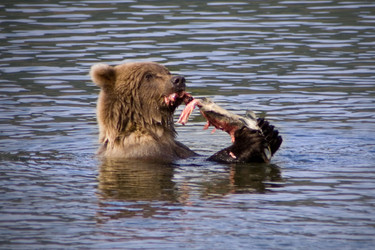
A grizzly bear eating a salmon at the Brooks Falls National Park in Alaska, USA. © 2006 Richard Forward
Although grizzly bears, like other brown bears, are classified as carnivores, they are in fact omnivores. Much of a grizzly's diet comes from berries, bulbs, roots, fruits, nuts as well as insects (Dewey and Ballenger, 2002). They are also adept hunters and can catch a variety of animals and fish depending on where they live. Grizzlies use their powerful digging skills and long claws to catch rodents and small mammals from their dens or holes. Hunting adult elk, moose or caribou is too dangerous for grizzlies, but one will never hesitate to eat a carcass that it finds. On the other hand, a gizzly will actively hunt elk, moose or caribou calves. Coastal bears rely heavily on salmon as their source for food (Mowat, 2006). They swim and stand in rivers flooded with salmon and catch the fish in their mouths. Grizzlies in the Yellowstone region show interesting feeding behaviour as for a time in the summer, their diet consists of almost exclusively of army cutworm moths.
Hunting Techniques
When searching for prey, grizzlies primarily rely on their acute sense of smell by bowing their heads low to the ground and sniffing while they walk. They also capitalize on their sight and hearing by periodically standing on their hind legs to gain a better view of their surroundings as well as hear further. While standing, they turn their head and ears in various directions to scan the area. Most of the time, a bear will not know where a herd of ungulates is located and can spend up to several hours conducting a search. Grizzlies are usually searching for calves that are lying down and sleeping, or bedding calves, as these are the easiest to catch. When a herd is located, the bear will pace around a 200 m radius where the herd was just previously standing in hopes of finding a bedding calf. While doing this, the bear will avoid being seen by the herd.
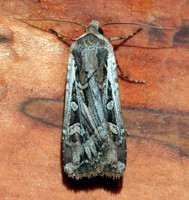
Army cutworm moths, Euxoa auxiliaris, are an important food source for some grizzly populations. Image © Whitney Cranshaw
When a bedding calf cannot be found, a grizzly can resort to a chase or an ambush to catch its prey. The bear will stalk a herd closely while remaining unseen, and suddenly attack with a burst of speed. They will focus on straggling calves that lag behind the herd and have little protection from adults. When the bear closes in on its prey it can knock it over with its muzzle or paw, and will usually begin eating the abdomen of the calf to quickly kill the victim. Grizzlies have been seen waiting on the edges of forests near fields and meadows for herds to enter where they can easily ambush their prey.
Large numbers of grizzly bears on the Absaroca Mountains in Yellowstone National Park rely heavily on army cutworm moths (Euxoa auxiliaris) as a main source of nutrition during the months of late June to mid September (French et al, 1994). Large numbers of moths arrive here during flowering season, and during the day take shelter under large rocks covering the side of the mountain. After locating a cluster of moths by their scent, the bears move rocks, dig and excavate until they find the moths. Although bears are found in large groups here, there is little social tension as plenty of food reduces the need for competition. Moth eating Grizzlies have also been found on Talus slopes in the Mission Mountains of Montana and in Glacier National Park.
Life Cycle
Female grizzlies typically mate every three years from June to mid July (Craighead et al., 1976). A female can become pregnant with 1-4 cubs per litter, but 2-3 cubs per litter is average. The cubs are born in January-March while the mother is still in hibernation and weigh only half a kilogram at birth (Dewey and Ballenger, 2002). The bears survive the winter by drinking from their mother’s milk and staying warm by her side. In the first year of the cubs' life, the mother is very protective of her young and is responsible for finding them food. Cubs stay with their mothers until at least the second spring of their lives, but some stay until the third or fourth. The young bears reach sexual maturity around 6-7 years old and continue growing until they are 10-11 years old.

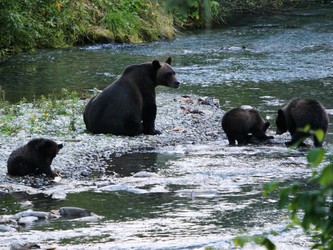
A grizzly bear female and her cubs at Hyder, Alaska, USA. © 2006 Jean-Guy Dallaire
Human Impact, Relations and Conservation
In the early 1800’s the grizzly bear population thrived in much of North America, but by 1975 much of their population had been devastated and extirpated in most of the contiguous United States except for 6 remote locations as well as 76% of their territory in Canada (Banci et al., 1994). This was caused without question by the destruction of habitat by the increasing human population. Expansion of cities, road and train building, deforestation, excavation of minerals and increased agriculture has decimated most of their former habitat and left populations isolated from one another (Banci et al, 1994). Another major factor in their population decline was the rapid decrease in the number of prey available; an example of this is the overhunting of bison in Canada and the US. The presence of roads and railway tracks through a forest often deters bears from crossing, and causes a decrease in the territory size of individuals as well as segregation of communities. In 1975, grizzly bears were listed as a threatened species by the US Fish and Wildlife Service and conservation efforts began to take hold.
Since that time, a wide variety of efforts have been made by governments to reduce human interaction with grizzly bears and to restore their population to a healthy size for their current area. Populations in Yellowstone and the Northern Continental Divide in the US have reached a recovered level (Strickland, 1989). Successful programs in the Yellowstone region have also nearly eliminated grizzly related injuries to humans since the 1960’s (Gunther, 1994). As hunting by humans is still a large risk to bear populations, reducing access to forests by hunters is being stressed by conservation agencies (McLellan, 1989). The populations of grizzly bears in Canada and Alaska are relatively stable and large enough to support themselves, and are protected by numerous national parks and hunting bans. Nevertheless, grizzlies need the constant security given by governments and conservation strategies to ensure that the bears do not undergo a population crash such as the one seen in the 19th and 20th century.
Information on the Internet
- Bear Aware British Columbia
- Animal Diversity Web: Ursus arctos
- Don's Maps Resources for the study of Palaeolithic European, Russian and Australian Archaeology: The Bear
- Safety guide to bears in the wild. Government of British Columbia.
- Grizzly bear recovery
- Grizzly bear facts. US Fish and Wildlife Service (pdf)

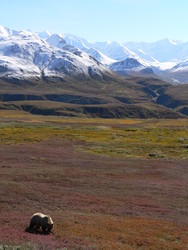



 Go to quick links
Go to quick search
Go to navigation for this section of the ToL site
Go to detailed links for the ToL site
Go to quick links
Go to quick search
Go to navigation for this section of the ToL site
Go to detailed links for the ToL site